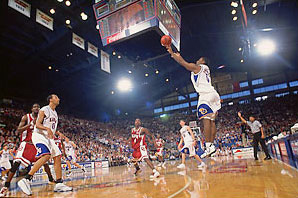Phog's house links past to present
Oddly, basketball is not what I think of first when I walk through the doors of Allen, so named for legendary coach Dr. Forrest C. "Phog" Allen, the second-most important figure in the history of basketball behind James Naismith, who founded the game and was Allen's coach at KU back in the early 1900s. An old-fashioned indoor track circles the arena, which opened in 1955, and the first time I saw it, I thought, "Damn, Jim Ryun ran here." I always bring my jogging shoes and make a dozen or so pathetic revolutions around the sacred ground, thinking about one of the great heroes of my youth, the first high-school runner to run a four-minute mile.
The second most striking feature -- no, it's not the basketball court itself, which is named for Naismith, who was the university's first coach -- are the KU Hall of Fame portraits located in the east lobby, big, bright vibrant things. There's Ryun and Wilt Chamberlain and Clyde Lovellette and Danny Manning and Larry Brown (who coached Manning to an NCAA title in 1988), but there, too, are athletes such as Brutus Hamilton and Bill Hargiss (track athletes from the 1930s) and an outstanding softball player named Sharon Drysdale from the 1970s. There might be a college or university that has thought of a better way to keep alive the legacy of the sporting past, but I haven't seen it.
Allen is not a dome, nor a glittering jewel, nor some megaplex named for an investment banker who gave $10 million so he could be remembered in perpetuity. It is a "fieldhouse" in every sense of the word, named for a man who played under Naismith, then coached himself at Kansas for 39 years, sending others such as Adolph Rupp and Dean Smith into the coaching world. The coaches have their offices right in Allen. One morning when he was still coaching at KU, Roy Williams opened his desk drawer and showed me a large collection of chocolate candy he keeps there during the season but never eats. It's one of the ways he keeps himself disciplined and focused.
Oh, the things that have happened at "the Phog" as it's called, though I prefer Allen Fieldhouse. In Phog's final game against Oklahoma State's Hank Iba, another highly influential figure in the development of the game, the Jayhawks won a 56-55 thriller on Jan. 31, 1956. In December of that same year, Chamberlain, who had come all the way to Lawrence from the streets of Philadelphia as the most-recruited athlete of his time, announced himself to the college world by scoring 52 points in his debut, an 87-69 win over Northwestern. Forty-one Februarys ago, Ryun set a world record in the 880 in Allen a time of 1:48.3 in a dual meet against Oklahoma State.
A lot of good stuff that doesn't have cobwebs on it happened in Allen, also -- Manning played some pretty good games there -- but, to me, what Allen Fieldhouse is about is preserving the past. Let's hope that some future Board of Trustees or college president doesn't get the bright idea to start "modernizing" and "expanding" and turning it into some place that would have ol' Phog turning over in his grave. Whatever's wrong with Kansas, it's not Allen Fieldhouse.
2. Franklin Field, Philadelphia Overshadowed by its better-known University of Pennsylvania neighbor, Franklin Field has the feel of a no-nonsense, old-fashioned football stadium, which is what it is. As a shivering 11-year-old in the Franklin Field's bleachers, I saw the Eagles beat the Packers to win the NFL championship on Dec. 26, 1960.
3. Key Arena, SeattleYeah, parking's a problem, the sight lines ain't great, space for corporate suites is at a minimum and Key's deficiencies are a major reason the Sonics are almost certainly leaving town. But it's still a great place to watch pro ball.
4. Sydney Olympic StadiumI never saw or heard anything like the stading-ovation din that accompanied Cathy Freeman all the way around the track as the pride of the Aborigine people won the 400-meter gold medal at this magical place in 2000.
5. Mays Landing (N.J.) School gymnasiumThe wooden floor and Naismith-era look of the place remains the same as when I learned to play basketball there some five decades ago. We used to risk detention, not to mention serious injury, to pry open the large windows that stood above the court to gain entree when school was closed.





